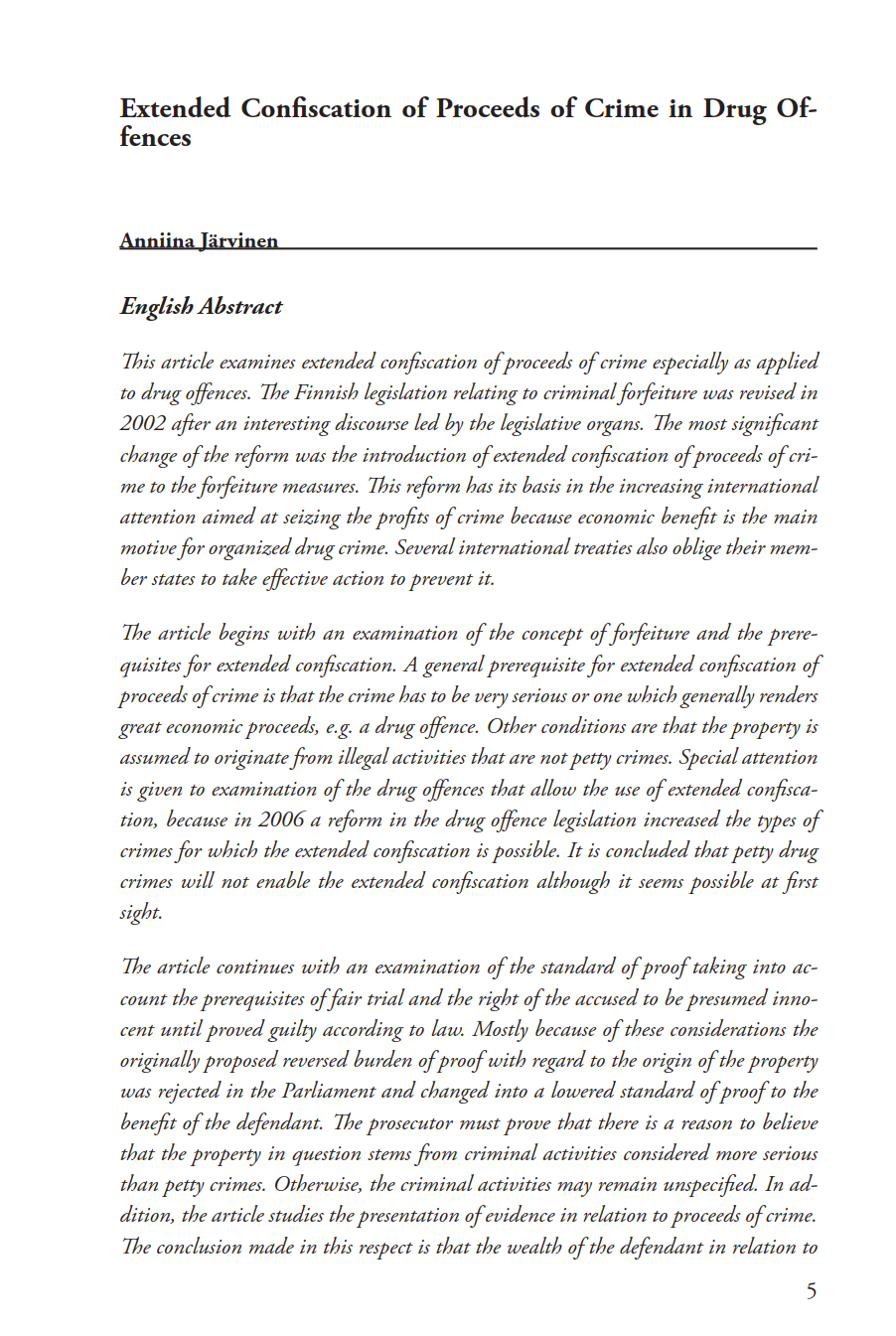Extended Confiscation of Proceeds of Crime in Drug Offences
DOI:
https://doi.org/10.33344/vol1iss1pp5-23Keywords:
huumausainerikos, hyödyn menettäminen, menettämisseuraamus, näyttökynnys, todistustaakkaAbstract
This article examines extended confiscation of proceeds of crime especially as applied to drug offences. The Finnish legislation relating to criminal forfeiture was revised in 2002 after an interesting discourse led by the legislative organs. The most significant change of the reform was the introduction of extended confiscation of proceeds of crime to the forfeiture measures. This reform has its basis in the increasing international attention aimed at seizing the profits of crime because economic benefit is the main motive for organized drug crime. Several international treaties also oblige their member states to take effective action to prevent it.
The article begins with an examination of the concept of forfeiture and the prerequisites for extended confiscation. A general prerequisite for extended confiscation of proceeds of crime is that the crime has to be very serious or one which generally renders great economic proceeds, e.g. a drug offence. Other conditions are that the property is assumed to originate from illegal activities that are not petty crimes. Special attention is given to examination of the drug offences that allow the use of extended confiscation, because in 2006 a reform in the drug offence legislation increased the types of crimes for which the extended confiscation is possible. It is concluded that petty drug crimes will not enable the extended confiscation although it seems possible at first sight.
The article continues with an examination of the standard of proof taking into account the prerequisites of fair trial and the right of the accused to be presumed innocent until proved guilty according to law. Mostly because of these considerations the originally proposed reversed burden of proof with regard to the origin of the property was rejected in the Parliament and changed into a lowered standard of proof to the benefit of the defendant. The prosecutor must prove that there is a reason to believe that the property in question stems from criminal activities considered more serious than petty crimes. Otherwise, the criminal activities may remain unspecified. In addition, the article studies the presentation of evidence in relation to proceeds of crime. The conclusion made in this respect is that the wealth of the defendant in relation to his legal sources of income or the unordinary nature of the property might give sufficient reason to believe that the property originates from illegal activities.
The article ends with an examination of legal praxis of the Supreme Court. So far, the Supreme Court has passed two judgments on the subject, of which the first upheld an extended confiscation in quite typical circumstances for the application of this measure. However, the other judgment did not uphold it, which might complicate the use of this forfeiture. The Supreme Court gave crucial importance to the fact that the defendant was not involved in a criminal organization nor had he committed the crime in an organized manner so that it was not necessary to apply the extended confiscation. This shows clearly the effects of the vagueness of the preparative works of the law reform. Thus the courts are confronted with the problem of defining what
kind of criminal activity allows the use of the extended confiscation. After all, this forfeiture is optional, and ought to be applied carefully. Nevertheless, it should be taken into consideration that too many rejections in its application might lead to it losing its intended effectiveness.


